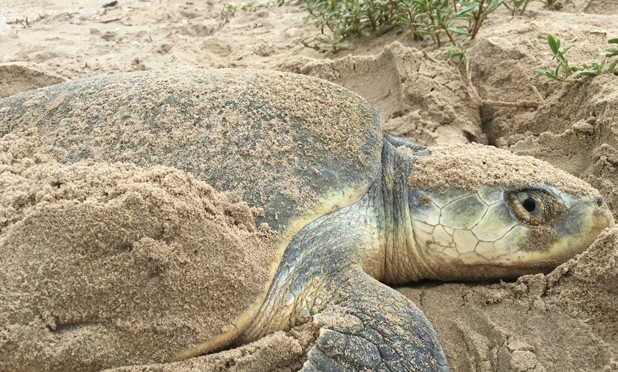Keep your eyes peeled while on the beach because the sea turtle nesting season along the Texas coast begins on April 1, 2017. Visitors to Texas beaches can help protect the most critically endangered sea turtle in the world, the Kemp’s ridley sea turtle, as well as the loggerhead and green sea turtles, by keeping an eye out for their nests along the beach. Visitors to Texas beaches from April through September are urged to watch for nesting adult sea turtles and emerging hatchlings and report them immediately
Biologists and volunteers will be patrolling Texas Gulf beaches daily from April through July to find and protect the nesting turtles and their eggs to help ensure their survival. The U.S. Fish and Wildlife Service (Service), the National Park Service, Texas Parks and Wildlife Department, Texas A&M University at Galveston, the University of Texas Marine Science Institute, and Sea Turtle Inc. on South Padre Island will be working together to coordinate a response when a nesting sea turtle or sea turtle nest is found. The Kemp’s ridley sea turtle is the smallest species of sea turtle, measuring about two feet long and weighing up to 100 pounds. Kemp’s ridley sea turtles usually come ashore during the daylight hours to lay eggs in the sand. Other species of sea turtles, primarily the loggerhead sea turtle and green sea turtle, also occasionally nest along the Texas coast but usually come ashore at night.
“A well informed and engaged public, along with a coordinated multi-agency conservation effort is vitally important for protecting our sea turtle populations in Texas,” said Benjamin Tuggle, Southwest Regional Director for the U.S. Fish and Wildlife Service. “Our efforts are greatly enhanced by beach goers who find and report nests along the Texas coast. The public's input strengthens our ability to undertake actions that help protect sea turtle populations.”
If a nesting sea turtle is seen, the Service advises visitors to quickly report the event by calling 1-866-TURTLE5 (1-866-887-8535). This telephone line is provided for and maintained by Turtle Island Restoration Project. Visitors must keep their distance and not disturb sea turtles. The female turtle will dig a nest in the sand and lay her eggs. After the turtle is finished laying her eggs, she must be allowed to enter the surf. If possible, anyone observing and reporting the event should remain at the site until a biologist arrives. Nesting sites should be marked by carefully laying pieces of beach debris, such as pieces of wood or plastic, in a large circle around the nest area, not on top of the nest, so biologists will be able to find the nest when they arrive. The nesting sites should never be walked on or disturbed.
In order to further help protect the species, the public is asked to drive slowly and carefully on beaches during the nesting and hatching seasons so that vehicles do not inadvertently collide with nesting turtles or emerging hatchlings. The maximum speed on a Texas beach per the Texas Transportation Code is 15 mph. Those visiting the beaches should be prepared for short delays in order to ensure that nesting turtles and hatchlings remain safe and undisturbed.
In 1947, an estimated 40,000 Kemp’s ridley turtles nested on one stretch of beach near Rancho Nuevo, Mexico. This was the only known nesting site at that time. Over the next four decades the species suffered a devastating decline. In response to the dramatic loss of this species, the Service and its partner agencies launched a cooperative international project aimed at nest protection efforts in the U.S. and Mexico, implementing regulations requiring the use of turtle excluder devices on commercial fishing trawlers, and establishing a second nesting colony of Kemp’s ridley sea turtles at the Padre Island National Seashore, Texas, where historical nesting had been documented. The cooperative efforts are now showing success for the Kemp’s ridley sea turtle. In 2016, the number of endangered Kemp’s ridley sea turtle nests found on the Texas coast rose to 186 from 159 in 2015. The highest number of nests in recent decades was 209 nests on the Texas coast in 2012.
Kemp’s ridley sea turtles are protected by the Endangered Species Act. Anyone who takes (to kill, harm, harass, pursue, hunt, shoot, wound, trap, capture, or collect, or attempt to engage in any such conduct), or has in their possession any part of these endangered turtles, could be found guilty of a Class A misdemeanor, with penalties of up to one year in jail and $100,000 fine for an individual, and $200,000 for an organization.
Report Sea Turtles Nesting, 1-866-TURTLE5 (1-866-887-8535)
Announcement courtesy of the U.S. Fish and Wildlife Service.









